A jacket keeps you warm in cold weather by trapping body-warmed air within its fibers. Insulated jackets typically use either down or synthetic insulation. While both insulations can provide good warmth, they do differ in weather resistance, drying time, durability, price and more. In the following we will explain what the differences between down and synthetic jackets (e.g. jackets which use synthetic insulation) are and help you clarify which type of jacket is right for your needs. Because not all insulation materials are necessarily high-quality we will also list both high-quality down insulations and high-quality synthetic insulations, and explain what makes them special. However, it is important to remember that the ultimate warmth provided by an insulated jacket does not only depend on the quality of the insulation (whether synthetic or down), but also on the amount of insulation used. If you are new to hiking also read our Hiking Clothing Guide.
Table of Contents:
- What are the differences between down and synthetic jackets?
- How to choose the right jacket/insulation?
- High-quality down insulations
- High-quality synthetic insulations
What are the differences between down and synthetic jackets?
Warmth/Weight
You might have heard that down jackets are warmer than jackets with synthetic insulation. Down jackets do indeed offer a much better weight-to-warmth ratio – meaning that they offer more warmth for their weight than jackets with synthetic insulation. Nevertheless, a jacket with 11 ounces of synthetic insulation can easily be warmer (but also heavier) than a jacket with 7 ounces of down insulation. The warmth of a down jacket depends on the quality of down. The quality of down is measured by the fill-power index which typically ranges from 300 to 900. The higher the fill-power index, the better (warmer) the down. The fill-power index tells us how much space one ounce of down occupies (in cubic inches). For example, one ounce of 400 fill-power down occupies 400 cubic inches while one ounce of down with the fill-power index of 800 occupies 800 cubic inches. The 800 fill-power down occupies more space than the 400 fill-power down because it’s much fluffier and has more tiny air pockets, which means that it can trap body-warmed air better and provide more warmth. But again, the ultimate warmth provided by a jacket also depends on the amount of down used.
The warmth of a jacket with synthetic insulation is typically measured by the CLO value. However, manufacturers rarely disclose CLO values for their jackets so it is hardly a factor to go by. In terms of the weight-to-warmth ratio, even the best jackets with synthetic insulation can’t perform better than a 600 fill power down jacket– which is rather mediocre down.
Weather Resistance
If you are into hiking, you have probably already heard that down jackets are not the best option for wet and humid conditions. This in indeed true, but let’s explain why. Insulated jackets provide warmth by trapping body warmed air into tiny air pockets which are created by the fibers of the insulation – try squeezing an insulated jacket (down or synthetic) and you’ll see how the air gets pushed out and the jacket compresses. One ounce of down, for example, has up to 2 million filaments and thus creates a large amount of tiny air pockets which trap body-warmed air. However, if down filaments get exposed to moisture/water they absorb it, become heavy and “glue” together. The insulation becomes flat and the air pockets are gone. Therefore, a wet down jacket can’t trap body-warmed air properly and thus provides very little warmth.
However, down can be treated with DWR (Durable Water Repellant) to resist moisture for longer. In humid and wet conditions DWR-treated down (also called hydrophobic down) therefore provides much better insulation than regular down. Check out this video to see the difference between hydrophobic down and regular down. Another option to make a down jacket more moisture-resistant is to include synthetic insulation in areas which get often wet (collar, shoulders, cuffs etc.). Many top-tier manufacturers such as Arcteryx, Outdoor Research etc. do that.
Synthetic insulation, on the other hand, provides better moisture resistance. Synthetic insulation is typically made of polyester fibers which mimic the structure of down clusters. As polyester fibers absorb very little moisture (they are naturally hydrophobic), synthetic insulation retains air pockets even if it gets exposed to moisture or water. It does, however, lose a certain percentage of warmth if it gets wet.
Drying Time
The drying time of a jacket depends on how much water the jacket absorbs; a jacket is dry when the water has completely evaporated from its fibers into the air. Therefore, it’s no surprise that jackets with synthetic insulation dry much faster than regular down jackets. However, jackets with hydrophobic down don’t dry much slower than jackets with synthetic insulation.
Packability
Down jackets typically contain more tiny air pockets (due to down being so fluffy) than jackets with synthetic insulation. Therefore, they compress better – a larger amount of air gets squeezed out. However, keep in mind that the volume of a packed jacket does not only depend on the type of insulation used, but also on the amount of insulation, type of face fabric, zippers etc. Nevertheless, a down jacket will almost always pack smaller than an equally warm jacket with synthetic insulation.
Durability
Down jackets are typically very durable and can easily last for a decade. Synthetic jackets, on the other hand, were for long considered to be less durable. However, modern first-class jackets with synthetic insulation have a comparable life expectancy as down jackets.
Price
Down jackets are more expensive than jackets with synthetic insulation. High-quality jackets with synthetic insulation typically cost from $150 to $300 while similar jackets with down insulation cost from $200 to $400. If you come across a more expensive jacket, it is probably designed for special purposes such as arctic expeditions etc.
Sustainability
In terms of sustainability, both jackets with down and synthetic insulation have their pros and cons. In terms of production, down involves farm animals (ducks and geese) which are not always properly treated while alive (force-feeding, live-plucking, stressing life conditions etc.) unless you make sure that your down jacket is certified through the RDS (Responsible Down Standard) or Global Traceable Down Standard. Ultimately, down is a side-product of the meat industry – so there are also ethical considerations to be made, when considering a down jacket versus a jacket with synthetic insulation. The latter derives from petroleum sources, and thus there is no live animals involved, although the whole extraction (and use!) of fossil fuels also involves environmental concerns, to say it mildly.
As mentioned above, high-quality synthetic insulation is now about as durable as down in terms of longevity if properly cared for (this applies to both), but once the insulation has lost so much loft that the jacket can no longer fulfill its purpose, the two insulation types degrade in different manners. While down is a natural material, which will disintegrate fast with no negative effective on the environment as waste, synthetic insulation can take decades or centuries to degrade in a landfill, or degrade into microplastics which can harm especially aquatic life. Regardless of which jacket you choose, you should, however, make sure to dispose of it in a better way than throwing it in a garbage container in order to reduce your environmental footprint (read some suggestions in this article). Maybe that old jacket of yours can be recycled in one way or another, that it doesn’t go to waste.
How to choose the right jacket/insulation?
So, which jacket is right for you? If you have a tight budget, a jacket with synthetic insulation is the obvious choice. A jacket with synthetic insulation is also a better option if you are often hiking in wet weather (rain, granular wet snow etc.) because it provides better warmth than a down jacket in such conditions. For all other conditions a down jacket is a better choice as it is lighter for the same warmth and packs smaller. For hiking in semi-humid conditions (for example dry snow), you should go for a jacket with DWR treated down as such jackets get less affected by moisture. I personally use CimAlp Primaloft synthetic jacket in cold humid conditions and Dark Peak down jacket in dry weather.
High-quality down insulations
High-quality down insulations include Mountain Hardwear’s Q Shield down and Rab’s Nikwax down (developed by Rab in cooperation with British company Nikwax). Both insulations are treated with high-quality durable water repellant so that they resist water and moisture. Therefore, jackets which use them offer good warmth even if they get exposed to water/moisture. See the video about Q. Shield down here and video about Nikwax down here.
High-quality synthetic insulations
High-quality synthetic insulations include PrimaLoft, Polartec Alpha, and G-Loft. All these insulations are made of hydrophobic polyester fibers which mimic down clusters to trap large amounts of body-warmed air. Mountain Hardwear’s video about Thermal Q Elite insulation here gives an in-depth insight into how the synthetic insulation is made and works.
I’d love to hear your thoughts Down vs Synthetic Jackets. Write them in the comments below.
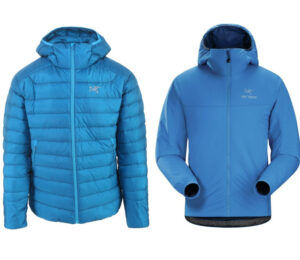
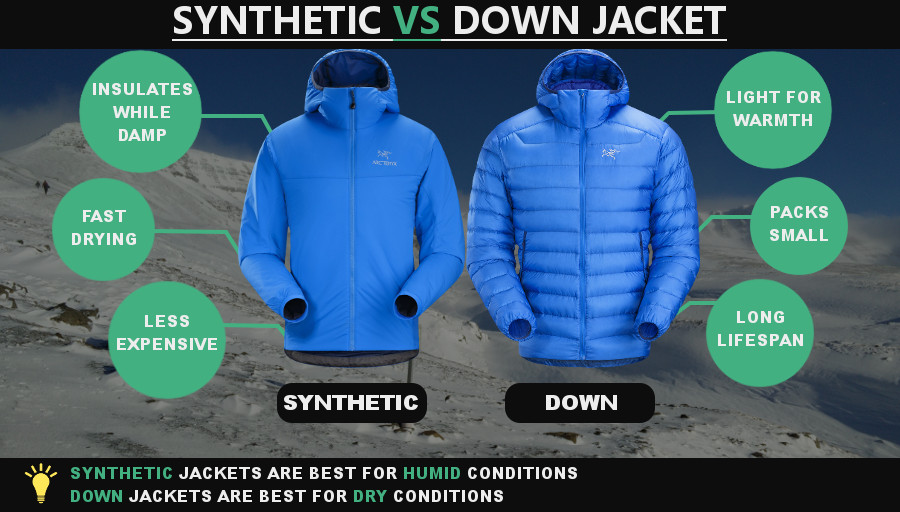
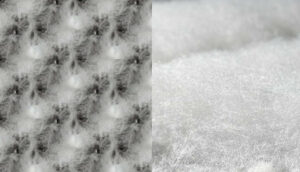
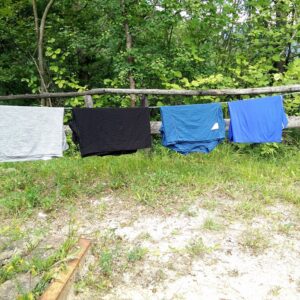
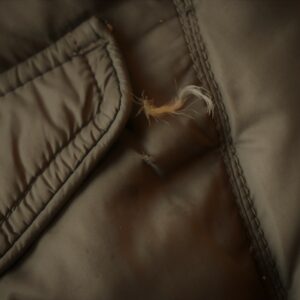
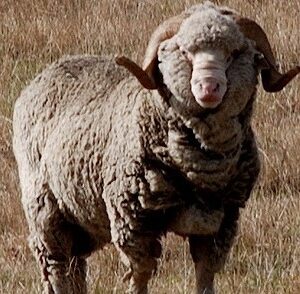
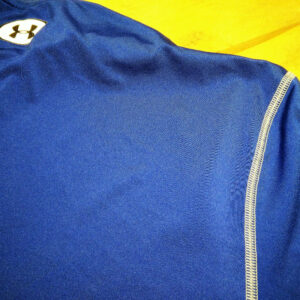


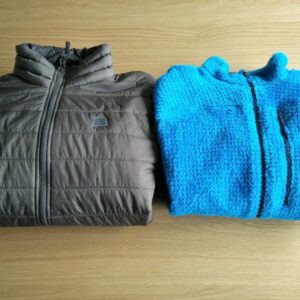
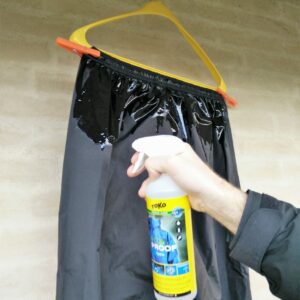
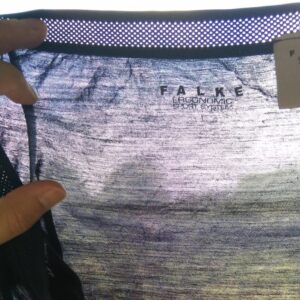












You wrote an essay on the topic my dude, and didn’t mention at all the ethics of what a down jacket is made of. We need to be having honest conversations about the true ethical price of saving that 4 oz of base weight. And I’m not talking about live plucking either. Regardless of RDS, animals are going to slaughter to keep you warm up on Forester Pass. If we’re having honest conversations on this, it’s worth mentioning at least in passing when talking about pros and cons of each.
Hi there,
That’s actually a very good point. I’ll be adding a section about sustainability and the ethics of animal welfare shortly.
Best regards,
Blaz
According to wikipedia it would be prohibitively expensive to raise geese for down alone. So the lower quality down of 300-650 is by product from young geese that are raised for consumption, The 700+ down comes from ducks that are grown for breeding purposes which molt naturally in the spring.
Thank you. I found this very helpful. It will help me make my choice in an educated way!